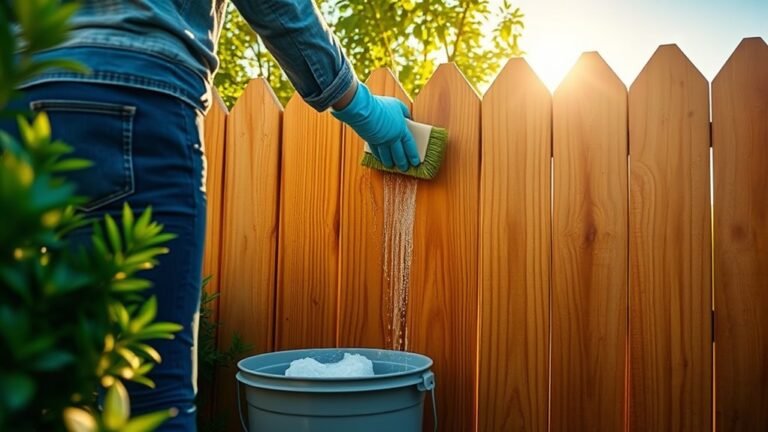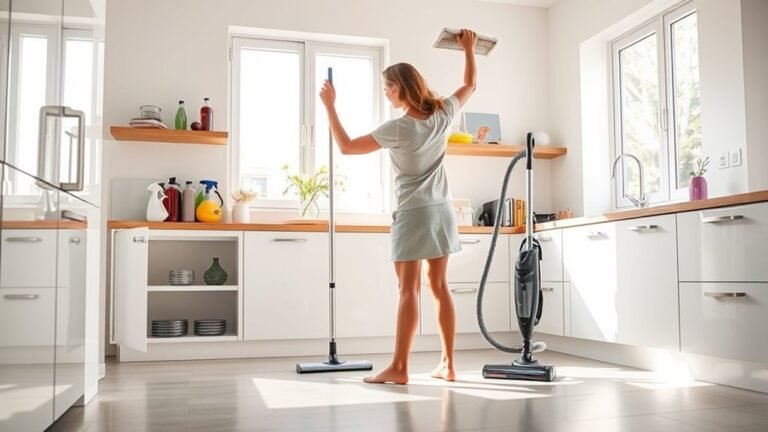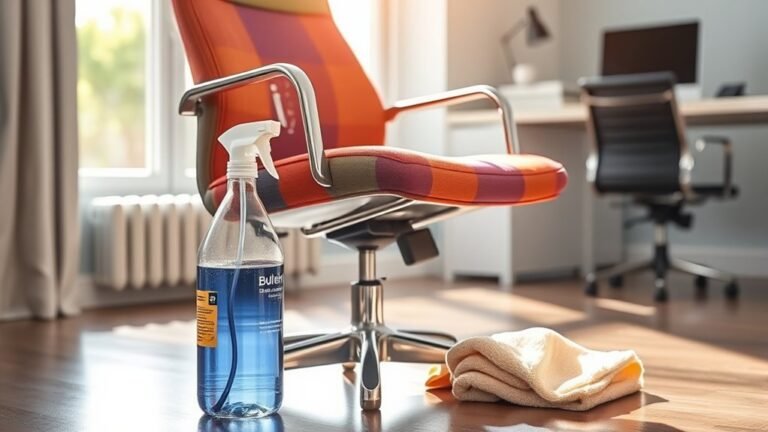Cleaning With Walls: What Works and What Doesn’T
When cleaning your walls, you’ll want to choose gentle solutions like diluted vinegar or mild soap to avoid damage, especially on painted or wallpapered surfaces. Avoid harsh chemicals, vigorous scrubbing, and over-wetting, which can worsen stains or ruin finishes. Textured or specialty walls need extra care with soft cloths or brushes. Regular touch-ups prevent build-up and keep walls fresh. Keep these basics in mind, and you’ll find effective ways to maintain your walls looking great with confidence.
Understanding Different Wall Surfaces

Before you start cleaning, it’s important to know what type of wall surface you’re dealing with because different materials require different care. You might have drywall, plaster, brick, or wood walls, each with unique wall materials that react differently to cleaning methods. Surface textures also play a big role—smooth surfaces are generally easier to clean, while textured or porous walls need gentler approaches to avoid damage. Understanding these differences gives you the freedom to choose the right technique without risking stains or wear. So, take a moment to inspect your walls closely. Recognizing your wall materials and surface textures lets you clean effectively and confidently, making your space shine without unnecessary hassle or harm.
Safe Cleaning Solutions for Painted Walls
When cleaning painted walls, you’ll want to choose gentle cleaners that won’t strip or damage the paint. It’s important to avoid harsh chemicals and abrasive tools to keep your walls looking fresh. You can even make simple homemade solutions that are both safe and effective for regular touch-ups.
Gentle Cleaners to Use
Although you might be tempted to reach for strong chemicals, gentle cleaners are best for painted walls to avoid damage. You want solutions that clean effectively without stripping paint or leaving residue. Eco friendly options like diluted vinegar or mild dish soap mixed with water offer a safe, breathable way to refresh your walls. When using these cleaners, apply them with a soft cloth or sponge and focus on gentle scrubbing—vigorous rubbing can harm the finish. This approach lets you maintain your freedom to keep your space spotless without risking costly repairs. Remember, selecting the right cleaner means preserving both your walls and your peace of mind. Keep it simple, green, and gentle for the best results every time.
Avoiding Paint Damage
Since painted walls can be sensitive to harsh chemicals and abrasive scrubbing, you’ll want to choose cleaning solutions that protect the finish while removing dirt. Different paint types and wall finishes react differently, so knowing your surface is key to avoid damage.
- Identify your paint type—matte, satin, or semi-gloss—to select an appropriate cleaner.
- Test any solution on a small, hidden spot to check for discoloration or damage.
- Use soft cloths or sponges to gently wipe, avoiding rough scrubbing that can strip paint.
- Avoid ammonia, bleach, or strong solvents that can degrade paint finishes.
Homemade Cleaning Solutions
Choosing the right cleaner for your painted walls doesn’t mean you have to rely on harsh chemicals or expensive products. You can easily make safe, effective homemade cleaning solutions that give you freedom from toxins and costs. A simple mix of homemade vinegar and water works wonders for removing dirt and grime without damaging paint. For tougher spots, sprinkle baking soda on a damp cloth and gently rub the area—its mild abrasiveness lifts stains without scratching. These natural ingredients are gentle yet powerful, letting you maintain your walls’ beauty while keeping your space healthy. Embracing homemade vinegar and baking soda solutions lets you clean confidently, knowing you’re protecting both your home and your well-being, all while enjoying the freedom to do it yourself.
Techniques for Removing Stains From Wallpaper
When you spot a stain on your wallpaper, the first step is to identify what kind it is to choose the safest cleaning method. You’ll want to use solutions that won’t damage the wallpaper’s texture or color. Let’s explore some effective techniques to remove different types of stains without causing harm.
Identifying Stain Types
Many stains on wallpaper can be tackled effectively once you know what you’re dealing with. Stain identification is your first step to freedom from stubborn marks. Pay attention to stain characteristics like color, texture, and how it reacts when you touch it. Here’s a quick guide to help you identify common wallpaper stains:
- Grease stains – look oily and dark, often from food or hands.
- Water stains – appear as discolored, sometimes wrinkled patches.
- Ink stains – usually sharp-edged and deep-colored, from pens or markers.
- Mold or mildew – fuzzy or spotty, with a musty smell.
Knowing these details lets you choose the right approach without guesswork, saving your wallpaper and your time.
Safe Cleaning Solutions
Although wallpaper can be delicate, you don’t have to worry about damaging it while cleaning. Choosing safe cleaning solutions is key to preserving your walls’ beauty without restricting your freedom to maintain a fresh space. Opt for products made with natural ingredients or eco friendly products; they’re gentle yet effective, reducing the risk of harm to your wallpaper and the environment. You can easily make your own cleaning mix using simple natural ingredients like baking soda, vinegar, or mild soap diluted in water. Always test any solution on a small, hidden area first to guarantee it won’t cause discoloration or damage. By using these safe, eco friendly options, you keep your walls spotless while staying true to a healthy, liberated lifestyle.
Stain Removal Techniques
If you want to keep your wallpaper looking fresh, knowing how to tackle stains quickly and correctly is essential. Start by embracing stain prevention tips like avoiding direct contact with dirty hands and placing mats near entryways. Regular wall cleaning frequency also helps prevent buildup, making stains easier to remove.
Here’s how you can handle stains effectively:
- Blot liquid stains immediately with a clean cloth—never rub.
- Use a mild soap solution for most stains; test first on a hidden area.
- For greasy spots, try a little baking soda paste applied gently.
- Tough stains may require specialized wallpaper cleaners—follow instructions precisely.
Best Practices for Cleaning Textured and Specialty Walls
Textured and specialty walls require a gentler touch and specific techniques to avoid damage while effectively removing dirt. When it comes to textured wall care, start by dusting with a soft brush or vacuum using a brush attachment to keep debris from embedding deeper. Avoid harsh scrubbing, which can ruin the texture or paint. For specialty wall maintenance—like wallpaper or faux finishes—use mild cleaning solutions and test a small area first to guarantee no discoloration. A damp microfiber cloth often does the trick without oversaturating the surface. Remember, your goal is to preserve the unique look and feel of these walls while keeping them fresh. With the right approach, you can maintain that sense of freedom in your space without compromising style or integrity.
Common Cleaning Mistakes to Avoid

When cleaning walls, it’s easy to make mistakes that can damage surfaces or leave them looking worse than before. Avoid falling into these traps by understanding common misconceptions and respecting cleaning timing.
- Using harsh chemicals blindly – Not all walls tolerate strong cleaners; test first.
- Ignoring surface type – Different textures need tailored methods; what works on smooth won’t suit textured.
- Cleaning too soon – Fresh paint needs curing time; premature cleaning can cause streaks or damage.
- Over-wetting walls – Excess moisture can lead to warping or mold; use damp, not soaked, cloths.
Tips for Maintaining Walls Between Deep Cleanings
Keeping your walls looking fresh between deep cleanings doesn’t have to be a chore. To simplify wall maintenance, focus on spot-cleaning marks and dust regularly. Use a soft cloth or sponge with mild soap to tackle fingerprints or smudges as they appear. This prevents dirt from settling and reduces the need for intensive scrubbing later. Adjust your cleaning frequency based on your lifestyle—busy households may need weekly touch-ups, while quieter spaces can get by with monthly care. Don’t forget to check corners and baseboards where dust loves to hide. By staying consistent and addressing issues early, you’ll preserve your walls’ appearance effortlessly and enjoy more freedom from constant, heavy cleaning sessions. Simple, routine care is the key to hassle-free wall maintenance.
Frequently Asked Questions
Can I Use a Pressure Washer on Exterior Walls?
You can use a pressure washer on exterior walls, and it offers great benefits like quickly removing dirt and grime, giving your home a fresh look. However, you’ve got to be careful, as high pressure can cause surface damage, especially on delicate materials like wood or stucco. To enjoy the freedom of a clean wall without harm, adjust the pressure settings and test a small area first to avoid costly repairs.
How Often Should I Repaint Walls After Cleaning?
You might worry that repainting walls often feels like a never-ending chore, but it’s actually about freedom—freedom from dull, damaged surfaces. Your repaint frequency depends on your wall condition; if you notice peeling, fading, or stains after cleaning, it’s time to refresh. Generally, repaint every 5-7 years outdoors, but check sooner if weather or wear takes a toll. Staying proactive keeps your space vibrant and carefree.
Are There Eco-Friendly Wall Cleaning Products Available?
Absolutely, you can find eco-friendly wall cleaning products that won’t compromise your freedom to live sustainably. Look for natural cleaners made from plant-based ingredients, which are gentle yet effective on walls. Biodegradable options break down harmlessly in the environment, so you’re not adding toxins to your space. These choices let you maintain a clean home while staying true to your values, giving you both cleanliness and peace of mind.
Can Mold Be Removed From Walls Without Professional Help?
Imagine reclaiming your space from mold without calling in the pros—sounds liberating, right? You can tackle mold removal yourself using DIY solutions like vinegar, baking soda, or hydrogen peroxide. These natural remedies are effective and eco-friendly, giving you control over your home’s cleanliness. Just wear gloves, ventilate the room, and scrub gently. With patience and care, you’ll beat mold and enjoy a fresher, healthier wall—no experts needed!
What Tools Are Best for Cleaning High or Hard-To-Reach Walls?
When tackling high or hard-to-reach walls, you’ll want an extendable pole to give you that extra reach without needing a ladder. Attach a microfiber cloth to the pole’s end—it’s gentle yet effective for dusting and wiping away grime. This combo lets you clean freely and safely, giving you control over those tricky spots without hassle. It’s all about making your cleaning routine easier and more liberating.






